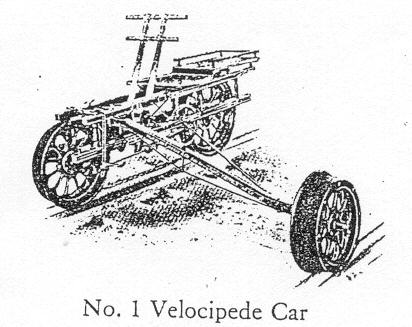The answer came in his invention of
a “velocipede” or three-wheeled, hand-powered vehicle made for travel on train
tracks. Without the railroad company's knowledge, Sheffield began driving his
velocipede between work and home. One night while driving, he discovered a
broken rail and alerted railroad officials in time to save a train from
derailing. His unique mode of transportation, now known to the officials, piqued
their interest and they requested he build several more.
 The velocipede proved useful
for track inspection and maintenance and in 1879 Sheffield patented it. Three years later the Sheffield Velocipede
Car Company incorporated. It grew and grew.
They made thousands of velocipedes and sold them the world over. At one
point, the company employed between 1,000 and 1,500 people and manufactured not
only velocipedes but also over 30 different types of cars for railroad repair,
milling, lumbering, contracting and plantation work.
The velocipede proved useful
for track inspection and maintenance and in 1879 Sheffield patented it. Three years later the Sheffield Velocipede
Car Company incorporated. It grew and grew.
They made thousands of velocipedes and sold them the world over. At one
point, the company employed between 1,000 and 1,500 people and manufactured not
only velocipedes but also over 30 different types of cars for railroad repair,
milling, lumbering, contracting and plantation work.
In the early 1900s, Sheffield
Car Company (“Velocipede" was dropped in 1892) consolidated with Fairbanks
Morse.
Products
included not only velocipede construction but also construction of engines for
the Navy, testing of pumps and marine parts and manufacture of copper wire.
Fairbanks Morse even built railroad motor cars, of which a handful still exist.
As late as
1955, the company still employed 365 workers in Three Rivers making hammer
mills, water tanks and custom metal work. Eventually the factory was sold
to the Essex Wire company and then to Decatur Elevator.
From 1994
to 2004 the huge metal buildings stood vacant.
Eventually heavily vandalized and in poor condition, the
city commission paid to have them demolished in 2004. Today
the site stands empty.
Drawings/Photos of the Factory
1999 Photos
of the Three Rivers Plant
The Plant Site in 2007
Miscellaneous Drawings and Photos
|
Excerpt from a letter written in 1995, author unknown
In
1946 I worked for Fairbanks Morse as a laborer's helper. I was there
but 4 to 6 weeks, but I recall the experience vividly. The plant was
old then but still made the 3-wheeled railroad track car. it made
coal stokers for delivering coal into the furnace fireboxes of
residential coal-fire furnaces and it also made parts for a F-M
diesel railroad locomotive. The major part it made was the huge
engine block for a unique 20-piston, I0-cylinder diesel engine and
it was welded, not cast. I'm sure the Three Rivers plant made other
locomotive parts but that part was notable. The locomotives were
assembled in Beloit, Wisconsin. There is one such locomotive in the
Southern Pacific RR yard in Sacramento...inoperative, of course,
unmistakably an F-M engine because of the engine's design necessary
to accommodate the huge diesel power plant.
I
recall that the plant made virtually everything in-house. It had its
own foundry, machine shop, et al. My job was to take the newly
casted parts, usually small, and stack them outside on wooden
pallets where they would stay for weeks "seasoning" in the sun and
weather...so explained my foreman. This was in response to my
question about handling the parts twice. I thought they should go
directly from the foundry to the machine shop. The coal stokers were
built, assembled and painted (burgundy and cream). Then shipped
directly to the wholesalers/installers.
|
 The velocipede proved useful
for track inspection and maintenance and in 1879 Sheffield patented it. Three years later the Sheffield Velocipede
Car Company incorporated. It grew and grew.
They made thousands of velocipedes and sold them the world over. At one
point, the company employed between 1,000 and 1,500 people and manufactured not
only velocipedes but also over 30 different types of cars for railroad repair,
milling, lumbering, contracting and plantation work.
The velocipede proved useful
for track inspection and maintenance and in 1879 Sheffield patented it. Three years later the Sheffield Velocipede
Car Company incorporated. It grew and grew.
They made thousands of velocipedes and sold them the world over. At one
point, the company employed between 1,000 and 1,500 people and manufactured not
only velocipedes but also over 30 different types of cars for railroad repair,
milling, lumbering, contracting and plantation work.